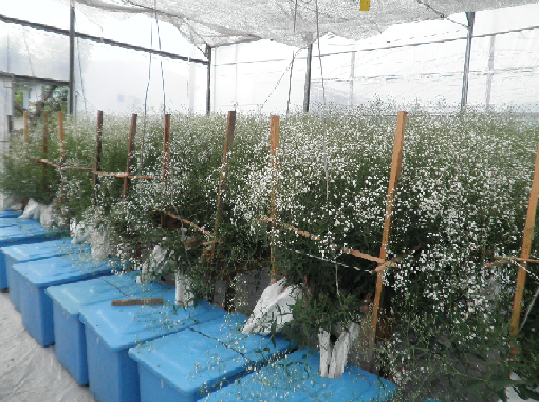Rice husk substrates and pruning time for gypsophila production

Abstract
This research evaluated the growth, yield and quality of gypsophila New Amore® variety grown in gutters filled with substrate in a system with leaching recirculation in southern Brazil. The treatments were the result of the combination of four substrates [carbonized rice husk (CRH100%), raw rice husk (RRH100%), CRH + organic commercial substrate S10 (Beifort®) (15%) and RRH+S10 (15%)] with two pruning times (early and late). The substrates did not affect the dry matter partitioning between the flowers and vegetative organs or the balance between the shoot and root growth. However, RRH100% reduced the shoot growth, flower stem yield and quality. The CRH100% and RRH+S10 substrates can be indicated for gypsophila cultivation once, in a general way, they presented promising results. The late pruning increased the gypsophila growth and yield and benefited the quality of the stems. The gypsophila plants adapted well to the employed crop system.
Keywords
Flower stems, yield, fertirrigation, alternative production systems, leaching recirculation
Author Biography
Daniela Höhn
Doutoranda do Programa de Pós-Graduação em sistemas de Produção Agrícola Familiar - SPAF
Roberta Marins Nogueira Peil
Departamento de Fitotecnia, Universidade Federal de Pelotas, Pelotas - RS (Brasil)
Lais Perin
Doutoranda do Programa de Pós-Graduação em sistemas de Produção Agrícola Familiar - SPAF
Priscila Monalisa Marchi
Doutoranda do Programa de Pós-Graduação em Agronomia - PPGA
Paulo Roberto Grolli
Departamento de Fitotecnia, Universidade Federal de Pelotas, Pelotas - RS (Brasil)
Albertina Radtke Wieth
Mestranda do Programa de Pós-Graduação em Fitotecnia da Universidade Federal de Rio Grande do Sul – UFRGS
References
- Andriolo, J.L., D.I. Jänisch, C.S. Oliveira, C. Cocco, O.J. Schmitt, and F.L. Cardoso. 2009. Cultivo sem solo do morangueiro com três métodos de fertirrigação. Ciênc. Rural 39(3), 691-695. Doi: 10.1590/S0103-84782009005000009
- Da Costa, J.C.F., R.M.N. Mendonça, L.F. Fernandes, F.P. Oliveira, and D. Santos. 2017. Caracterização física de substratos orgânicos para o enraizamento de estacas de goiabeira. Rev. Bras. Agropecu. Sustent. 7(2), 16-23. Doi: 10.21206/rbas.v7i2.390
- Dorajeerao, A.V.D. and A.N. Mokashi. 2013. Growth analysis as influenced by pinching time in garland chrysanthemum (Chrysanthemum coronarium L.). Global J. Bio-Sci. Biotechnol. 2(1), 242-247.
- Ferreira, E.A., M. Pasqual, V. Mendonça, and N.F. Pires. 2008. Influencia de diferentes substratos e fertilizantes na aclimatação de plantas de figueira (Ficus Carica L.). Rev. Caatinga 21(5), 64-68.
- Ibraflor (Instituto Brasileiro de Floricultura). 2016. Critério de classificação Gypsophila paniculata. In: http://www.ibraflor.com/publicacoes/vw.php?cod=163; consulted: October, 2017.
- Girardi, L.B., M.X. Peiter, R.A. Bellé, F.A. Backes, F.S. Soares, and I. Valmorbida. 2012. Disponibilidade hídrica e seus efeitos sobre o desenvolvimento radicular e a produção de Gypsophila envasada em ambiente protegido. Irriga 17, 501-509. Doi: 10.15809/irriga.2012v17n4p501
- Medeiros, C.A.B., A.S. Strassburger, and L.E.C. Antunes. 2008. Casca de arroz e sua carbonização para utilização em substratos. Circular Técnica. Embrapa Clima Temperado, Pelotas, Brazil.
- Peil, R.M.N., A.A.R. Albuquerque Neto, and C.V. Rombaldi. 2014. Densidade de plantio e genótipos de tomateiro cereja em sistema fechado de cultivo em substrato. Hort. Bras. 32, 234-240. Doi: 10.1590/S0102-05362014000200021
- Petry, C., S. Bellé, and E.O. Calvete. 2008. Produção de gypsophila. pp. 172-178. In: Petry, C. (ed.). Plantas ornamentais aspectos para a produção. 2nd ed. Editora Universidade de Passo Fundo, Passo fundo, Brazil.
- Pires, R.C.M., P.R. Furlani, R.V. Ribeiro, D.B. Junior, E. Sakai, A.L. Lourenção, and A.T. Neto. 2011. Irrigation frequency and substrate volume effects in the growth and yield of tomato plants under greenhouse conditions. Sci. Agric. 68(4), 400-405. Doi: 10.1590/S0103-90162011000400002
- Sonneveld, C. and N. Straver. 1994. Nutrient solutions for vegetebles and flowers grown in water or substrates. 10th ed. Series Voeding Soplossingen Glastuinbouw. Proefstation voor Tuinbouw onder Glas, Naaldwijk, The Netherlands.
- Steffen, G.P.K., Z.I. Antiniolli, R.B. Steffen, and R.G. Machado. 2010. Cáscara de arroz y estiércol bovino como sustratos para la multiplicación de lombrices de tierra y la producción de plántulas de tomate y lechuga. Acta Zool. Mex. 26, 333-343.
- Wahome, P.K., T.O. Oseni, M.T. Masarirambi, and V.D. Shongwe. 2011. Effects of different hydroponics systems and growing media on the vegetative growth, yield and cut flower quality of gypsophila (Gypsophila paniculata L.). World J. Agr. Sci. 7(6), 692-698.
